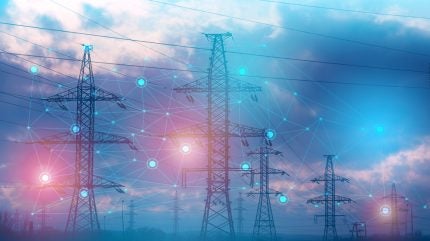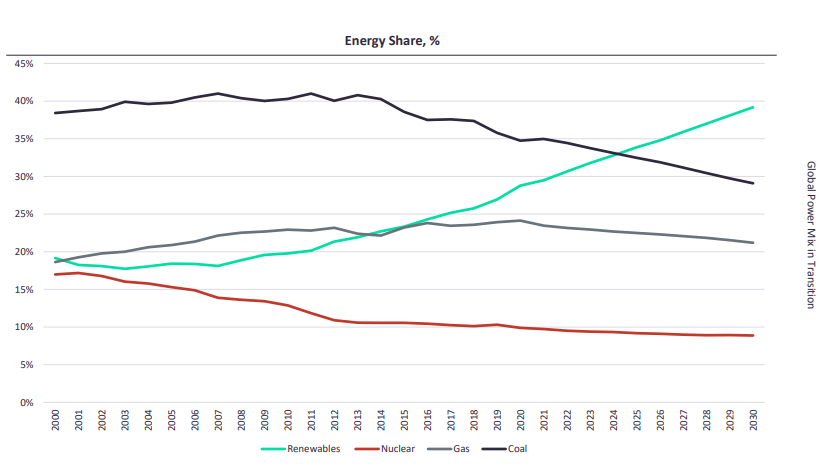
By 2030, almost 40% of global energy demand will be powered by renewables. But integrating renewable energy sources into the power grid presents a number of challenges due to their intermittent nature and the mismatch between peak renewable energy generation and demand. Accurate forecasting is also a problem due to weather variability.

Traditional grids designed for centralised energy sources require significant upgrades. Even in countries with well-established power grids, there is a need to update to adapt to an evolving generation mix, using next-gen connectivity solutions to enhance grid resilience and establish cross-border interconnections between regions.
However, current energy storage solutions are not yet capable of responding to contemporary demand cycles, and innovative business solutions and technology models, such as vehicle-to-grid systems and microgrids, are still in their infancy.
Traditional power grids suffer from significant energy losses during transmission and distribution, affecting overall efficiency and increasing operational costs. These losses can be attributed to factors such as ageing infrastructure, inefficient technologies, and limited monitoring capabilities.
Technology’s role in the energy transition
The role of technology and how it can be leveraged to improve efficiency and reduce carbon emissions in the energy transition was explored at the 26th World Energy Conference in Rotterdam in April. Industry leaders gathered for a panel discussion where the conversation centred around the potential of technology to drive the energy transition, with a focus on automation, digitalisation, AI, sustainability software and the importance of investing in these technologies.
Panel member, Jason Li, President of Global Marketing & Solutions for Huawei Electric Power Digitalization Business Unit, outlined to Congress how Huawei believes traditional automation technologies alone cannot solve the challenges of modern-day electric grid management, which needs to manage hundreds of millions of unstable and unpredictable objects and complex processes. To address this, Huawei uses digital platform and technologies like cloud computing and AI.
“In China, installed capacity will grow from 760 gigawatts to 1530 gigawatts from 2022 to 2025,” Li told the panel. “In just three years, that will more than double. Alongside that, distributed PV [photovoltaic] energy will increase from 158 gigawatt to 298 gigawatt…an astonishing number. EV cars in China will increase to 45 million by 2025, and EV charging will grow from six million to 22 million.”

Microsoft’s Darryl Willis – also on the panel – commented on the importance of AI within the energy sector: “AI is going to be an enabler for everything we’re doing around the digitalisation and the decarbonisation of the energy sector. It’s moving very fast. We are having interesting conversations around this journey from preventive to predictive to what is being called prescriptive maintenance. It will allow companies to start to see around corners using data.”
Li also spoke about investment within the industry: “Digitalisation for the electric sector is not only a technology upgrade, but also transformation of the entire industry. Therefore, we should change our mindset. Investment in a large power plant costs billions of dollars, but the investment – in the past – in digitalisation, accounted for less than 2% of the total revenue of the power company.
“Only when digitalisation investment reaches 4 to 5% of the total revenue, can we attract more talent and industry players. As a result, customers will also be encouraged to invest more in digitalisation, which leads to a productive cycle, called the compound interest effect. We should all focus on that and to try to bring more digital technology into the industry.”
Huawei’s Intelligent Distribution Solution (IDS)
As the backbone of the power supply system, the power distribution network ensures the ‘last mile’ of power supply to industry and householders. With the continuing construction of future power systems, and upgrading of existing ones, distribution networks are facing ever more challenges to load management, mixed energy generation and consumer demand such as EV charging and digital charging meters.
This challenge led Huawei to collaborate with ecosystem partners to develop a new solution, which would address high line loss, poor reliability, and heavy pressure on new energy load management. Converged smart terminals replace multiple electrical equipment, minimising natural line loss and automating the operation of intelligent equipment. Implementing these changes enhances the overall perception state of the distribution network, leading to improved work efficiency.
Huawei’s Intelligent Distribution Solution (IDS) uses both digital and IoT (Internet of Things) technology alongside ‘cloud-pipe-edge-pipe-device’ architecture to build a unified distribution network.
Benefits of the IDS include:
- Reduced line-loss with real-time analysis
- Improved power supply reliability, with quick and accurate fault finding reduced to just minutes
- New energy management with data collected minute-by-minute
- Improved online and manual inspection (with remote automatic inspection)
- Agile development of new services. Using apps, new services can be deployed in just weeks.
The use of AI has been instrumental in advancing grid automation technologies, including remote monitoring and fault detection. Advanced data analytics and machine learning techniques help utilities analyse data, optimise maintenance schedules, integrate EV charging infrastructure, and more.
Huawei’s IDS is an innovative initiative in the power industry. It offers several advantages, including meeting growing energy demands, enabling renewable energy integration, and building a sustainable, resilient future. It also helps utility providers meet these demands efficiently and sustainably, balancing supply and demand, managing fluctuations, and optimising energy storage solutions. Up to now, it has shown promising results in initial tests across multiple countries in the Middle East, Asia, and Africa.
IDS contributes to a more resilient energy future by integrating renewable sources, reducing line losses, and optimising grid operations, thereby supporting global efforts to combat climate change and promote clean energy.
For more information on Huawei’s Intelligent Distribution Solution (IDS) click here.


